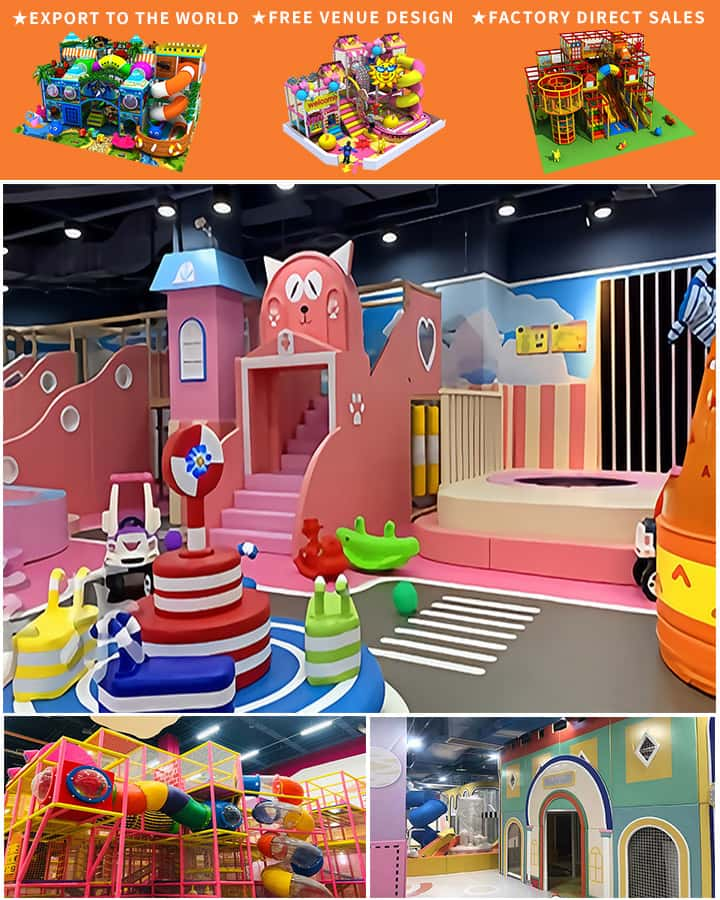Creating an indoor play area that captivates children’s imagination while ensuring their safety is a task that requires thoughtful planning and creativity. Whether you are designing a commercial play space, such as a children’s gymnasium or a dedicated corner in your home, this guide will help you craft a delightful and secure environment for young ones to enjoy.
Assessment and Planning
Identify the Purpose and Audience
The first step in developing an indoor play area plan is to identify the primary purpose of the space and the age group it will cater to. Is it intended for toddlers, preschoolers, or a mix of different age groups? Understanding this will influence the types of equipment and activities you include.
Safety First
Safety is paramount in any play area. Ensure that all materials used meet national safety standards. The flooring should be non-slip and impact-absorbent—options like rubber mats or foam tiles can be ideal. All furniture and play structures should have rounded edges to minimize injury risk.
Space Allocation
Sketch out a rough layout of the area, considering the available space and how it can be divided into various zones. Typical zones might include:
- Physical Activity Zone: Incorporate soft climbing walls, small slides, and balance beams.
- Creative Play Zone: Provide tables for arts and crafts, easels, and storage for supplies.
- Imaginative Play Zone: Set up themed areas such as a mini kitchen or market with pretend food and cash registers.
- Quiet Zone: Include a cozy reading nook with bean bags, cushions, and a variety of books.
Equipment and Materials

Age-Appropriate Equipment
Choose equipment suitable for the age range you are targeting. For toddlers, low-level platforms and simple puzzles are great. Preschoolers can enjoy more complex climbing structures and interactive learning tools.
- Soft Play Equipment: Foam blocks, balls, and soft mats.
- Interactive Toys: Digital learning games and interactive panels that encourage cognitive development.
- Sensory Play Items: Water tables, sand pits (with fine-grained substitutes), and textured toys enhance sensory exploration.
Versatility and Flexibility
Incorporate multi-purpose items that grow with the child. Modular furniture, like stackable blocks and adjustable-height tables, can be reconfigured as needed. This not only saves space but also allows for continuous engagement as the child develops new skills.
Aesthetic Considerations
Color Scheme
Bright, cheerful colors can stimulate children’s senses and create an inviting atmosphere. Use a cohesive color scheme that matches the play area’s theme or desired ambiance. Soft pastels can create a calming effect, while vibrant hues can energize the space.
Lighting
Proper lighting is crucial for safety and visibility. Natural light is best, but supplement with soft, warm artificial lighting if necessary. Avoid harsh overhead lights; instead, use dimmable lamps and strategically placed lights to create a comfortable environment.
Decor
Decorate the play area with engaging wall art, murals, or decals related to the themes within each zone. Educational posters and interactive boards can add both charm and learning opportunities.
Maintenance and Sustainability
Easy Cleaning
Select materials that are easy to clean and maintain. Washable fabrics for cushions and washable paint for tables and walls can make daily upkeep manageable.
Eco-Friendly Choices
Consider eco-friendly options where possible. Non-toxic, sustainable wood and recycled plastic are good choices for building materials. Look for items with minimal packaging to reduce waste.
Engaging Activities and Programs
Scheduled Events
Offer scheduled activities like storytime, yoga sessions, or science experiments to keep the play area dynamic and educational. These events can foster social interaction and learning beyond physical play.
Parental Involvement
Encourage parental involvement through designated times when parents or guardians can accompany their children. Workshops teaching safe play practices or DIY craft days can also be popular additions.
Conclusion
Designing an indoor play area involves balancing safety, creativity, and functionality. By meticulously planning each aspect—from initial assessment to final decor—you can create a space that is not only enjoyable but also enriching for children. An indoor play area, when thoughtfully designed, becomes a haven of joy, learning, and growth, making every moment spent truly memorable for the young ones.




